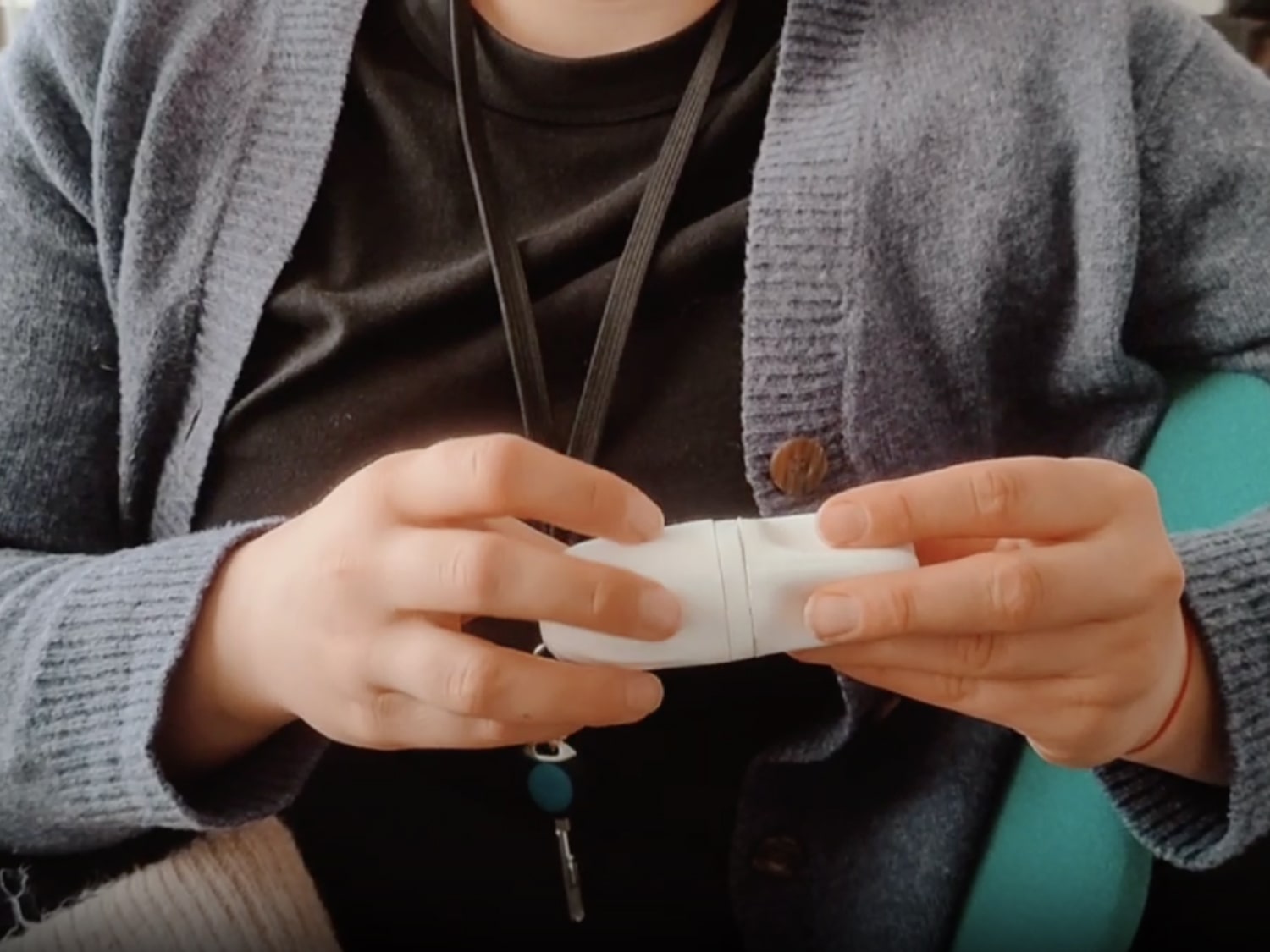Fokus(1)
How can we harness the power of fidgeting to enable stronger and more sustained attention? Fokus(1) is a fidgeting device that combines sensory feedback with biofeedback technology for improved concentration and stress management.
| ID: | #011.22 |
| Status: | Completed Prototype |
| Client: | Aalto University |
| Year: | 2022 |
| Collab: | Natalia Trzmielak, Nicolas Robertson |
| Discover: | n/a |

Challenge
Reconceptualizing fidgeting from a distracting habit to becoming a beneficial tool for enhancing focus and managing stress.
Is fidgeting the key to better concentration? The primary challenge of our Fokus(1) project was to shift the narrative around fidgeting. Traditionally perceived as a sign of distraction or boredom, especially in educational and professional environments, fidgeting needed to be recognized for its potential benefits.
Inspired by observations like Ellen's (see the video below ↓) - who instinctively fidgeted to maintain concentration - the project aimed to harness this natural tendency as a positive, focusing mechanism. The project confronted the stereotype that stillness equates to focus and sought to validate the role of physical movement in cognitive function.
Inspired by observations like Ellen's (see the video below ↓) - who instinctively fidgeted to maintain concentration - the project aimed to harness this natural tendency as a positive, focusing mechanism. The project confronted the stereotype that stillness equates to focus and sought to validate the role of physical movement in cognitive function.
Approach
Our approach to Fokus(1) combined desktop research, rapid prototyping and rigorous testing, all aimed at making fidgeting a beneficial activity
We developed the Fokus(1) in following key steps:
Our team began by researching what makes fidgeting so satisfying. There was limited information available, so we focused on discovering what kind of movements are most enjoyable. Through rapid prototyping and testing various shapes and movements, we identified a candy-shaped design that rotates around an axis as the most pleasing for fidgeting.
The device needed to be small and portable, which meant miniaturizing the electronics as well. We equipped Fokus(1) with an Arduino Nano, a small coin cell vibration motor for tactile feedback, hall-effect sensors, and magnets to track the rotations during fidgeting. Additionally, we integrated a Galvanic Skin Response (GSR) sensor to measure the user’s stress levels while they interact with the device.
The coding of the device was crucial. We programmed Fokus(1) to produce a mild vibration with each rotation. This vibration intensifies as the user's stress level increases, measured through the GSR sensor. This feature is key to the device's ability to adapt to the user’s current state and provide appropriate sensory feedback to aid in concentration and stress relief.
(A) Understanding Fidgeting
Our team began by researching what makes fidgeting so satisfying. There was limited information available, so we focused on discovering what kind of movements are most enjoyable. Through rapid prototyping and testing various shapes and movements, we identified a candy-shaped design that rotates around an axis as the most pleasing for fidgeting.
(B) Compact Design and Electronics
The device needed to be small and portable, which meant miniaturizing the electronics as well. We equipped Fokus(1) with an Arduino Nano, a small coin cell vibration motor for tactile feedback, hall-effect sensors, and magnets to track the rotations during fidgeting. Additionally, we integrated a Galvanic Skin Response (GSR) sensor to measure the user’s stress levels while they interact with the device.
(C) Responsive Feedback System
The coding of the device was crucial. We programmed Fokus(1) to produce a mild vibration with each rotation. This vibration intensifies as the user's stress level increases, measured through the GSR sensor. This feature is key to the device's ability to adapt to the user’s current state and provide appropriate sensory feedback to aid in concentration and stress relief.
Outcome & Impact
Fokus(1) dynamically adapts to your stress levels, transforming your fidgeting into a tailored tool
In this project, we designed the candy-shaped Fokus(1) - a device that can both measure (a) how a person fidgets and (b) what a person's stress level is, all the while changing the fidget interaction on the basis of a stress level.
Think of it in this context: you've been attending a lecture for about an hour and are half-aware silently fidgetting in one hand. The fidget device learns how you're focussing, how you're interacting with the device. Now you're working on a homework problem. It's hard. You are fidgetting in one hand, but quite frantically doing it.
We can change your interaction with the Fokus(1) automatically: we can estimate that you're stressed, and we ramp up the vibration a little. Now the fidget device generates a different response and hopefully guides you towards new attention states.
Think of it in this context: you've been attending a lecture for about an hour and are half-aware silently fidgetting in one hand. The fidget device learns how you're focussing, how you're interacting with the device. Now you're working on a homework problem. It's hard. You are fidgetting in one hand, but quite frantically doing it.
We can change your interaction with the Fokus(1) automatically: we can estimate that you're stressed, and we ramp up the vibration a little. Now the fidget device generates a different response and hopefully guides you towards new attention states.
Reflection
In six weeks, our team developed dual prototypes of Fokus, paving the way for an integrated, advanced stress-detection tool.
With the three of us, in a span of six weeks we made the Fokus work! - albeit not in one device. For the eventual final presentation during our course “From Concepts to Design” we prepared a looks-like device and a works-like device. Our next step is integrating all the components into one device and test it as a research platform to better and improve the algorithm that detects a users stress level.




